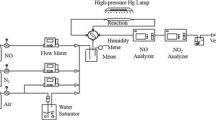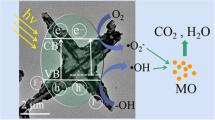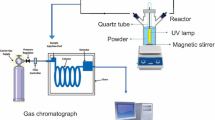Abstract
Anatase/brookite nanoparticles were prepared by low-temperature hydrolysis and polycondensation of titanium isopropoxide in the presence of low concentrations of acetic acid substituted in the α−position with Cl, F, NH2 or OH groups. A bridging mechanism described the formation of TiO2 with heterophase junctions between anatase and brookite. Substituted acetic acids formed short Ti---X-CH2-COO---Ti bridges that held neighboring Ti species close together and facilitated their condensation and the formation of Ti-O-Ti bonds. The structure of the anatase-brookite heterophase junctions was located and fully characterized by HR-TEM. The most acidic acetic acids substituted with groups with a strongly negative inductive effect, monochloroacetic, dichloroacetic, trichloroacetic, trifluoroacetic and amino acetic acids, supported the formation of TiO2, which in cooperation with the Pt cocatalyst had photocatalytic activity, 144.6–165.6 μmol H2/min. g, in the production of hydrogen. All photocatalysts had a pronounced mesoporous structure and a large specific surface area (212.6 to 247.2 m2/g), which contributed to the high photocatalytic activity.
Graphical Abstract

Heterophase anatase-brookite photocatalysts were prepared by hydrolysis and polycondensation of titanium isoproproxide in a solution of substituted acetic acids. Bridges between substituted acetic acids and Ti atoms supported the formation of heterophase anatase-brookite junctions, which formed highly active photocatalysts in hydrogen production.
Highlights
-
Heterophase anatase-brookite nanoparticles were prepared by hydrolysis and polycondensation of titanium isopropoxide in a solution of substituted acetic acids.
-
The bridges between substituted acetic acids and Ti atoms facilitate the formation of heterophase anatase-brookite junctions.
-
Anatase-brookite heterophase junctions deposited by Pt nanoparticles formed photocatalytically active centers.
-
acetic acids substituted with Cl-, F- and NH2- groups produced highly active photocatysts in hydrogen production.
















Similar content being viewed by others
References
Abe R (2010) Recent progress on photocatalytic and photoelectrochemical water splitting under visible light irradiation. J Photoch Photobio C 11(4):179–209. https://doi.org/10.1016/j.jphotochemrev.2011.02.003
Fujishima A, Honda K (1972) Electrochemical photolysis of water at a semiconductor electrode. Nature 238(5358):37–38. https://doi.org/10.1038/238037a0
Fujishima A, Honda K, Kikuchi S (1969) Photosensitized electrolytic oxidation on TiO2 semiconductor electrode. J Chem Soc Jpn 72:108–109
Cheng G, Wei Y, Xiong JY, Gan YX, Zhu JX, Xu FF (2017) Same titanium glycolate precursor but different products: successful synthesis of twinned anatase TiO2 nanocrystals with excellent solar photocatalytic hydrogen evolution capability. Inorg Chem Front 4(8):1319–1329. https://doi.org/10.1039/c7qi00278e
D’Elia D, Beauger C, Hochepied JF, Rigacci A, Berger MH, Keller N, Keller-Spitzer V, Suzuki Y, Valmalette JC, Benabdesselam M, Achard P (2011) Impact of three different TiO2 morphologies on hydrogen evolution by methanol assisted water splitting: Nanoparticles, nanotubes and aerogels. Int J Hydrog Energy 36(22):14360–14373. https://doi.org/10.1016/j.ijhydene.2011.08.007
Bokhimi X, Morales A, Aguilar M, Toledo-Antonio JA, Pedraza F (2001) Local order in titania polymorphs. Int J Hydrog Energy 26(12):1279–1287. https://doi.org/10.1016/S0360-3199(01)00063-5
Kakihana M, Kobayashi M, Tomita K, Petrykin V (2010) Application of water-soluble titanium complexes as precursors for the synthesis of titanium-containing oxides via aqueous solution processes. B Chem Soc Jpn 83(11):1285–1308. https://doi.org/10.1246/bcsj.20100103
Di Paola A, Cufalo G, Addamo M, Bellardita M, Campostrini R, Ischia M, Ceccato R, Palmisano L (2008) Photocatalytic activity of nanocrystalline TiO2 (brookite, rutile and brookite-based) powders prepared by thermohydrolysis of TiCl4 in aqueous chloride solutions. Colloids Surf A Physicochem Eng Asp 317(1–3):366–376. https://doi.org/10.1016/j.colsurfa.2007.11.005
Diebold U (2003) The surface science of titanium dioxide. Surf Sci Rep. 48(5-8):53–229. https://doi.org/10.1016/S0167-5729(02)00100-0
Kumar SG, Rao KSRK (2014) Polymorphic phase transition among the titania crystal structures using a solution-based approach: from precursor chemistry to nucleation process. Nanoscale 6(20):11574–11632. https://doi.org/10.1039/c4nr01657b
Kobayashi M, Petrykin V, Tomita K, Kakihana M (2008) New water-soluble complexes of titanium with amino acids and their application for synthesis of TiO2 nanoparticles. J Ceram Soc Jpn 116(1352):578–583. https://doi.org/10.2109/jcersj2.116.578
Tomita K, Petrykin V, Kobayashi M, Shiro M, Yoshimura M, Kakihana M (2006) A water-soluble titanium complex for the selective synthesis of nanocrystalline brookite, rutile, and anatase by a hydrothermal method. Angew Chem Int Ed 45(15):2378–2381. https://doi.org/10.1002/anie.200503565
Kobayashi M (2016) Synthesis and development of titania with controlled structures. J Ceram Soc Jpn 124(9):863–869
Shen X, Zhang J, Tian B, Anpo M (2012) Tartaric acid-assisted preparation and photocatalytic performance of titania nanoparticles with controllable phases of anatase and brookite. J Mater Sci 47(15):5743–5751. https://doi.org/10.1007/s10853-012-6465-4
Tay QL, Liu XF, Tang YX, Jiang ZL, Sum TC, Chen Z (2013) Enhanced photocatalytic hydrogen production with synergistic two-phase Anatase/Brookite TiO2 nanostructures. J Phys Chem C 117(29):14973–14982. https://doi.org/10.1021/jp4040979
Froschl T, Hormann U, Kubiak P, Kucerova G, Pfanzelt M, Weiss CK, Behm RJ, Husing N, Kaiser U, Landfester K, Wohlfahrt-Mehrens M (2012) High surface area crystalline titanium dioxide: potential and limits in electrochemical energy storage and catalysis. Chem Soc Rev 41(15):5313–5360. https://doi.org/10.1039/c2cs35013k
El -Sheikh SM, Khedr TM, Hakki A, Ismail AA, Badawy WA, Bahnemann DW (2017) Visible light activated carbon and co-doped mesoporous TiO2 as efficient photocatalyst for degradation of ibuprofen. Sep Purif Technol 173:258–268. https://doi.org/10.1016/j.seppur.2016.09.034
Cihlar J, Kasparek V, Kralova M, Castkova K (2015) Biphasic anatase-brookite nanoparticles prepared by sol-gel complex synthesis and their photocatalytic activity in hydrogen production. Int J Hydrog Energy 40(7):2950–2962. https://doi.org/10.1016/j.ijhydene.2015.01.008
Buonsanti R, Grillo V, Carlino E, Giannini C, Kipp T, Cingolani R, Cozzoli PD (2008) Nonhydrolytic synthesis of high-quality anisotropically shaped Brookite TiO2 Nanocrystals. J Am Chem Soc 130(33):11223–11233. https://doi.org/10.1021/ja803559b
Liu SH, Bai SQ, Zheng YG, Shah KW, Han MY (2012) Composite metal-oxide nanocatalysts. Chemcatchem 4(10):1462–1484. https://doi.org/10.1002/cctc.201200264
Cihlar J, Navarro LKT, Kasparek V, Michalicka J, Cihlar J, Kastyl J, Castkova K, Celko L (2021) Influence of LA/Ti molar ratio on the complex synthesis of anatase/brookite nanoparticles and their hydrogen production. Int J Hydrog Energy 46(12):8578–8593. https://doi.org/10.1016/j.ijhydene.2020.12.080
Serpone N, Lawless D, Khairutdinov R (1995) Size effects on the photophysical properties of colloidal anatase TiO2 particles: size quantization versus direct transitions in this indirect semiconductor. J Phys Chem 99(45):16646–16654. https://doi.org/10.1021/j100045a026
Alcaraz de la Osa R, Iparragirre I, Ortiz D, Saiz JM (2019) The extended Kubelka–Munk theory and its application to spectroscopy. ChemTexts 6(1):2. https://doi.org/10.1007/s40828-019-0097-0
Cihlar Jr. J, Bartonickova E, Cihlar J (2013) Low-temperature sol–gel synthesis of anatase nanoparticles modified by Au, Pd and Pt and activity of TiO2/Au, Pd, Pt photocatalysts in water splitting. J Sol-Gel Sci Technol 65(3):430–442. https://doi.org/10.1007/s10971-012-2955-8
Melián EP, López CR, Méndez AO, Díaz OG, Suárez MN, Doña Rodríguez JM, Navío JA, Fernández Hevia D (2013) Hydrogen production using Pt-loaded TiO2 photocatalysts. Int J Hydrog Energy 38(27):11737–11748. https://doi.org/10.1016/j.ijhydene.2013.07.006
Doeuff SH M, Sanchez C, Livage J (1987) Hydrolysis of titanium alkoxides: modification of the molecular precursor by acetic acid. J Non-Cryst Solids 89:206–216
Livage J, Henry M, Sanchez C (1988) Sol-gel chemistry of transition metal oxides. Prog Solid State Chem 18(4):259–341. https://doi.org/10.1016/0079-6786(88)90005-2
Brinker CJ, Schere, GW (1990) Sol-gel science:the physics and chemistry of sol-gel processing. Academic Press, Inc., San Diego
Venz PA, Frost RL, Kloprogge JT (2000) Chemical properties of modified titania hydrolysates. J Non-Cryst Solids 276(1–3):95–112. https://doi.org/10.1016/S0022-3093(00)00267-2
Venz PA, Kloprogge JT, Frost RL (2000) Chemically modified titania hydrolysates: physical properties. Langmuir 16(11):4962–4968. https://doi.org/10.1021/la990830u
Ignatyev IS, Montejo M, González JJL (2010) Theoretical study of the mechanisms of the hydrolysis and condensation reactions of silicon and titanium alkoxides: similarities and differences. Dalton T 39(30):6967–6973. https://doi.org/10.1039/C002397C
Cheng X, Chen D, Liu Y (2012) Mechanisms of silicon alkoxide Hydrolysis–Oligomerization reactions: A DFT investigation. Chemphyschem 13(9):2392–2404. https://doi.org/10.1002/cphc.201200115
Zhang H, Chen B, Banfield JF, Waychunas GA (2008) Atomic structure of nanometer-sized amorphous TiO2. Phys Rev B 78(21):214106. https://doi.org/10.1103/PhysRevB.78.214106
Petkov V, Holzhüter G, Tröge U, Gerber T, Himmel B (1998) Atomic-scale structure of amorphous TiO2 by electron, X-ray diffraction and reverse Monte Carlo simulations. J Non-Cryst Solids 231(1):17–30. https://doi.org/10.1016/S0022-3093(98)00418-9
Ojamäe L, Aulin C, Pedersen H, Käll PO (2006) IR and quantum-chemical studies of carboxylic acid and glycine adsorption on rutile TiO2 nanoparticles. J Colloid Interface Sci 296(1):71–78
Pantaleone S, Rimola A, Sodupe M (2017) Canonical, deprotonated or zwitterionic? A computational study on amino acid interaction with the TiO2 (101) anatase surface. J Phys Chem C 121. https://doi.org/10.1021/acs.jpcc.7b03305
Pantaleone S, Rimola A, Sodupe M (2020) Canonical, deprotonated, or zwitterionic? II. A computational study on amino acid interaction with the TiO2 (110) rutile surface: comparison with the anatase (101) surface. Phys Chem Chem Phys 22(29):16862–16876. https://doi.org/10.1039/D0CP01429J
Liu L, Li K, Chen X, Liang X, Zheng YZ, Li L (2018) Amino acid adsorption on anatase (101) surface at vacuum and aqueous solution: a density functional study. J Mol Model 24:1–9
Xue X, Huang Y, Zhuang Z, Huang F, Lin Z (2013) Temperature-sensitive growth kinetics and photoluminescence properties of CdS quantum dots. Crystengcomm 15(24):4963–4969. https://doi.org/10.1039/C3CE40478A
Xue X, Penn RL, Leite ER, Huang F, Lin Z (2014) Crystal growth by oriented attachment: kinetic models and control factors. Crystengcomm 16(8):1419–1429. https://doi.org/10.1039/C3CE42129E
Dalmaschio CJ, Ribeiro C, Leite ER (2010) Impact of the colloidal state on the oriented attachment growth mechanism. Nanoscale 2(11):2336–2345. https://doi.org/10.1039/C0NR00338G
Khan MM, Ansari SA, Pradhan D, Ansari MO, Han DH, Lee J, Cho MH (2014) Band gap engineered TiO2 nanoparticles for visible light induced photoelectrochemical and photocatalytic studies. J Mater Chem A 2(3):637–644
Kalaivani T, Anilkumar P (2018) Role of temperature on the phase modification of TiO2 nanoparticles synthesized by the precipitation method. Silicon 10(4):1679–1686. https://doi.org/10.1007/s12633-017-9652-8
Huang GZ, Zhang J, Jiang F, Zhang Z, Zeng JH, Qi X, Shen ZJ, Wang HB, Kong Z, Xi JH, Ji ZG (2020) Excellent photoelectrochemical activity of Bi2S3 nanorod/TiO2 nanoplate composites with dominant {001} facets. J Sol State Chem 281. https://doi.org/10.1016/j.jssc.2019.121041
Bharti B, Kumar S, Lee H-N, Kumar R (2016) Formation of oxygen vacancies and Ti3+ state in TiO2 thin film and enhanced optical properties by air plasma treatment. Sci Rep-Uk 6(1):32355. https://doi.org/10.1038/srep32355
Lv C, Lan X, Li F, Wang L, Xiao L, Wang C, Shi J, Yu S (2020) A facile acid treatment for P25 modification with enhanced photocatalytic H2 evolution – effect of Brønsted acid sites and oxygen vacancies. Catal Sci Technol 10(3):690–699. https://doi.org/10.1039/C9CY02166C
Huang GC, Liu XY, Shi SR, Li ST, Xiao ZT, Zhen WQ, Liu SW, Wong PK (2020) Hydrogen producing water treatment through mesoporous TiO2 nanofibers with oriented nanocrystals. Chin J Catal 41(1):50–61. https://doi.org/10.1016/S1872-2067(19)63424-8
Li X, Liu CY, Wu DY, Li JZ, Huo PW, Wang HQ (2019) Improved charge transfer by size-dependent plasmonic Au on C3N4 for efficient photocatalytic oxidation of RhB and CO2 reduction. Chin J Catal 40(6):928–939. https://doi.org/10.1016/S1872-2067(19)63347-4
Khedr TM, El-Sheikh SM, Hakki A, Ismail AA, Badawy WA, Bahnemann DW (2017) Highly active non-metals doped mixed-phase TiO2 for photocatalytic oxidation of ibuprofen under visible light. J Photochem Photobio A 346:530–540. https://doi.org/10.1016/j.jphotochem.2017.07.004
Hariharan D, Christy AJ, Mayandi J, Nehru LC (2018) Visible light active photocatalyst: Hydrothermal green synthesized TiO2 NPs for degradation of picric acid. Mater Lett 222:45–49. https://doi.org/10.1016/j.matlet.2018.03.109
Chattopadhyay S, Mishra MK, De G (2016) Functionalized C@TiO2 hollow spherical architecture for multifunctional applications. Dalton T 45(12):5111–5121. https://doi.org/10.1039/c5dt05011a
Wang DT, Li X, Chen JF, Tao X (2012) Enhanced photoelectrocatalytic activity of reduced graphene oxide/TiO2 composite films for dye degradation. Chem Eng J 198:547–554. https://doi.org/10.1016/j.cej.2012.04.062
Elmouwahidi A, Bailon-Garcia E, Castelo-Quiben J, Perez-Cadenas AF, Maldonado-Hodar FJ, Carrasco-Marin F (2018) Carbon-TiO2 composites as high-performance supercapacitor electrodes: synergistic effect between carbon and metal oxide phases. J Mater Chem A 6(2):633–644. https://doi.org/10.1039/c7ta08023a
Lee ASH, Li K, Zhang YW, Sha ZD, Pan H (2014) Ab initio study on the effects of dopant-defect cluster on the electronic properties of TiO2-based photocatalysts. Int J Hydrog Energy 39(5):2049–2055. https://doi.org/10.1016/j.ijhydene.2013.11.090
Tay Q, Chen Z (2016) Effective charge separation towards enhanced photocatalytic activity via compositing reduced graphene oxide with two-phase anatase/brookite TiO2. Int J Hydrog Energy 41(25):10590–10597. https://doi.org/10.1016/j.ijhydene.2016.04.022
Zhang Z, Maggard PA (2007) Investigation of photocatalytically-active hydrated forms of amorphous titania, TiO2·nH2O. J Photochem Photobio A: Chem 186(1):8–13. https://doi.org/10.1016/j.jphotochem.2006.07.004
Hao R, Jiang BJ, Li MX, Xie Y, Fu HG (2015) Fabrication of mixed-crystalline-phase spindle-like TiO2 for enhanced photocatalytic hydrogen production. Sci China Mater 58(5):363–369. https://doi.org/10.1007/s40843-015-0052-3
Thommes M, Kaneko K, Neimark AV, Olivier JP, Rodriguez-Reinoso F, Rouquerol J, Sing KSW (2015) Physisorption of gases, with special reference to the evaluation of surface area and pore size distribution (IUPAC Technical Report). Pure Appl Chem 87(9-10):1051–1069. https://doi.org/10.1515/pac-2014-1117
Liao Y, Que W, Jia Q, He Y, Zhang J, Zhong P (2012) Controllable synthesis of brookite/anatase/rutile TiO2 nanocomposites and single-crystalline rutile nanorods array. J Mater Chem 22(16):7937–7944. https://doi.org/10.1039/C2JM16628C
Beltram A, Romero-Ocana I, Jaen JJD, Montini T, Fornasiero P (2016) Photocatalytic valorization of ethanol and glycerol over TiO2 polymorphs for sustainable hydrogen production. Appl Catal A Gen 518:167–175. https://doi.org/10.1016/j.apcata.2015.09.022
Khedr TM, El-Sheikh SM, Ismail AA, Bahneman DW (2019) Highly efficient solar light-assisted TiO2 nanocrystalline for photodegradation of ibuprofen drug. Opt Mater 88:117–127. https://doi.org/10.1016/j.optmat.2018.11.027
Kurnaravel V, Mathew S, Bartlett J, Pillai SC (2019) Photocatalytic hydrogen production using metal doped TiO2: A review of recent advances. Appl Catal B:Environ 244:1021–1064. https://doi.org/10.1016/j.apcatb.2018.11.080
Rosseler O, Shankar MV, Du MK-L, Schmidlin L, Keller N, Keller V (2010) Solar light photocatalytic hydrogen production from water over Pt and Au/TiO2(anatase/rutile) photocatalysts: Influence of noble metal and porogen promotion. J Catal 269(1):179–190. https://doi.org/10.1016/j.jcat.2009.11.006
Reichert R, Jusys Z, Behm RJ (2015) Au/TiO2 Photo(electro)catalysis: the role of the au cocatalyst in photoelectrochemical water splitting and photocatalytic H2 evolution. J Phys Chem C 119(44):24750–24759. https://doi.org/10.1021/acs.jpcc.5b08428
Chen W-T, Chan A, Al-Azri ZHN, Dosado AG, Nadeem MA, Sun-Waterhouse D, Idriss H, Waterhouse GIN (2015) Effect of TiO2 polymorph and alcohol sacrificial agent on the activity of Au/TiO2 photocatalysts for H2 production in alcohol–water mixtures. J Catal 329:499–513. https://doi.org/10.1016/j.jcat.2015.06.014
Panagiotopoulou P, Karamerou EE, Kondarides DI (2013) Kinetics and mechanism of glycerol photo-oxidation and photo-reforming reactions in aqueous TiO2 and Pt/TiO2 suspensions. Catal 209:91–98. https://doi.org/10.1016/j.cattod.2012.09.029
Izumi Y (2013) Recent advances in the photocatalytic conversion of carbon dioxide to fuels with water and/or hydrogen using solar energy and beyond. Coord Chem Rev 257(1):171–186. https://doi.org/10.1016/j.ccr.2012.04.018
Walenta CA, Courtois C, Kollmannsberger SL, Eder M, Tschurl M, Heiz U (2020) Surface species in photocatalytic methanol reforming on Pt/TiO2(110): learning from surface science experiments for catalytically relevant conditions. Acs Catal 10(7):4080–4091
Tay Q, Liu X, Tang Y, Jiang Z, Sum TC, Chen Z (2013) Enhanced photocatalytic hydrogen production with synergistic two-phase anatase/brookite TiO2 nanostructures. J Phys Chem C 117(29):14973–14982. https://doi.org/10.1021/jp4040979
Kandiel TA, Feldhoff A, Robben L, Dillert R, Bahnemann DW (2010) Tailored titanium dioxide nanomaterials: anatase nanoparticles and brookite nanorods as highly active photocatalysts. Chem Mater 22(6):2050–2060. https://doi.org/10.1021/cm903472p
Ocana IR, Beltram A, Jaen JJD, Adami G, Montini T, Fornasiero P (2015) Photocatalytic H-2 production by ethanol photodehydrogenation: Effect of anatase/brookite nanocomposites composition. Inorg Chim Acta 431:197–205. https://doi.org/10.1016/j.ica.2015.01.033
Preethi LK, Antony RP, Mathews T, Walczak L, Gopinath CS (2017) A study on doped heterojunctions in TiO2 Nanotubes: an efficient photocatalyst for solar water splitting. Sci Rep-Uk 7. ARTN 14314 https://doi.org/10.1038/s41598-017-14463-0
Preethi LK, Mathews T, Nand M, Jha SN, Gopinath CS, Dash S (2017) Band alignment and charge transfer pathway in three phase anatase-rutile-brookite TiO2 nanotubes: An efficient photocatalyst for water splitting. Appl Catal B:Environ 218:9–19. https://doi.org/10.1016/j.apcatb.2017.06.033
Wang YL, Zhang W, Wang ZH, Cao YM, Feng JM, Wang ZL, Ma Y (2018) Fabrication of TiO2(B)/anatase heterophase junctions in nanowires via a surface-preferred phase transformation process for enhanced photocatalytic activity. Chin J Catal 39(9):1500–1510. https://doi.org/10.1016/S1872-2067(18)63096-7
Xiong HL, Wu LL, Liu Y, Gao TN, Li KQO, Long Y, Zhang R, Zhang L, Qiao ZA, Huo QS, Ge X, Song SY, Zhang HJ (2019) Controllable synthesis of mesoporous TiO2 polymorphs with tunable crystal structure for enhanced photocatalytic H-2 production. Adv Energy Mater 9 (31). ARTN 1901634 https://doi.org/10.1002/aenm.201901634
Acknowledgements
The work was carried out in the frame of the COST Action CA18125 “Advanced Engineering and Research of aeroGels for Environment and Life Sciences” (AERoGELS) and funded by the European Commission. The authors acknowledge the support of the Ministry of Education, Youth and Sports of the Czech Republic under grant no. LTC20019. We also acknowledge CzechNanoLab Research Infrastructure supported by MEYS CR (project LM2018110).
Funding
This work was supported by Ministry of Education, Youth and Sports of the Czech Republic under Grant numbers LTC20019.
Author information
Authors and Affiliations
Contributions
(CRediT author statement) All authors contributed to the study conception and design. JC: conceptualization, supervision, methodology, investigation, writing - original draft. KTN: investigation, visualization. JC: visualization, investigation, formal analysis. VK: investigation. JM: formal analysis, writing - original draft. KC: project administration, validation, writing - review & editing. IL: writing - original draft, writing - review & editing. JK: formal analysis, writing - original draft. LC: resources, validation. MV: resources, funding acquisition. PD: resources, funding acquisition. The first draft of the manuscript was written by JC and all authors commented on previous versions of the manuscript. All authors read and approved the final manuscript.
Corresponding author
Ethics declarations
Conflict of interest
The authors declare no competing interests.
Additional information
Publisher’s note Springer Nature remains neutral with regard to jurisdictional claims in published maps and institutional affiliations.
Supplementary Information
Rights and permissions
Springer Nature or its licensor (e.g. a society or other partner) holds exclusive rights to this article under a publishing agreement with the author(s) or other rightsholder(s); author self-archiving of the accepted manuscript version of this article is solely governed by the terms of such publishing agreement and applicable law.
About this article
Cite this article
Cihlar, J., Navarro, L.K.T., Cihlar, J. et al. Influence of substituted acetic acids on “bridge” synthesis of highly photocatalytic active heterophase TiO2 in hydrogen production. J Sol-Gel Sci Technol 105, 471–488 (2023). https://doi.org/10.1007/s10971-022-06011-8
Received:
Accepted:
Published:
Issue Date:
DOI: https://doi.org/10.1007/s10971-022-06011-8




